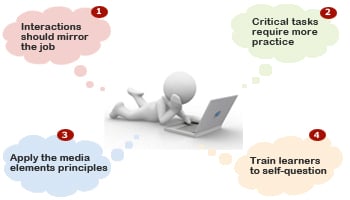Principles for Effective Practice Exercises

I was going through the book, e-Learning and the Science of Instruction by Ruth Colvin Clark & Richard E Mayer to refresh my mind and update my knowledge. Here, I would like to share the principles for effective practice exercises, which I follow for creating practice exercises from this book.

Principle 1: Interactions should mirror the job
- The features and processes of the practice exercises used in e-learning must match the features and process of the work environment (job-realistic context).
- The job-realistic context activities get encoded into the long-term memory and help in easy retrieval of information at the job.
- Avoid using recognize or recall information as it doesn’t transfer learning to the job.
- Simulation questions require learners to make certain kinds of decisions. Hence, they are more likely to support transfer of learning.
Principle 2: Critical tasks require more practice
- Use as many good questions as you can as they enhance learning and improve your performance.
- For critical tasks, use lots of practice exercises and, in those places where job skills can be gained at work, use fewer practice exercises.
- Practice exercises should be distributed throughout a lesson as they result in better long-term retention.
Principle 3: Apply the media elements principle
- The directions for practice exercises should be distinguished by placement, color or font and placed adjacent to the question.
- Feedback should be placed near the question and response area.
- The learner should see four components on the screen when they answer a question – directions, question, response and feedback.
- Do not narrate on-screen text directions or practice questions.
Principle 4: Train learners to self-question during receptive e-lessons
- There are certain situations where learners need to learn from the lesson that lacks practice.
- Learners can learn by asking questions regarding the content presented – this is known as receptive learning.
- Provide learners with generic question stems, worked examples or job aids.
Do you follow any specific guidelines while creating practice exercise? Please share your thoughts on this subject here.



![All About Authoring Tools: 5 FAQs Answered [Infographic]](https://blog.commlabindia.com/hubfs/Imported_Blog_Media/authoring-tools-more-questions-answered-info.jpg)
![6 Questions E-learning Vendors Will Ask Before Development [Infographic]](https://blog.commlabindia.com/hubfs/Imported_Blog_Media/elearning-vendor-questions-infographic-2.jpg)
![eLearning Outsourcing – Why and How You Should do it? [Infographic]](https://blog.commlabindia.com/hubfs/Imported_Blog_Media/eLearning-Outsourcing-Why-and-How-You-Should-do-it-Infographic.jpg)